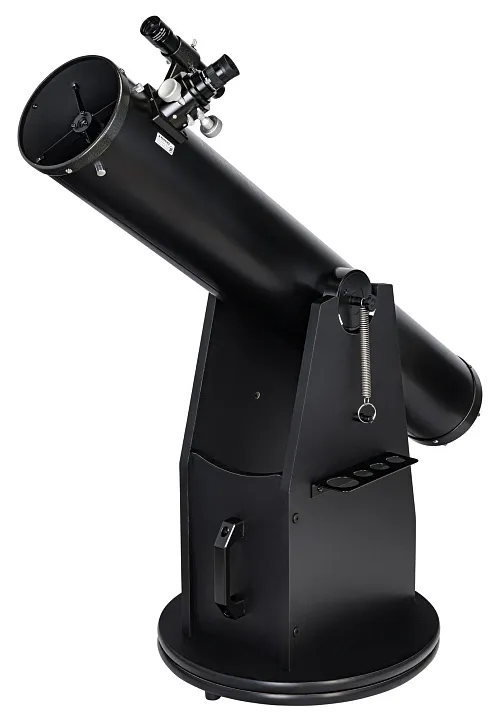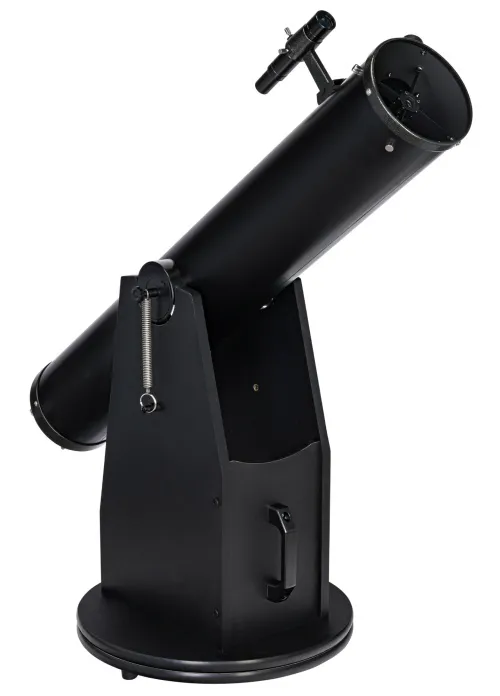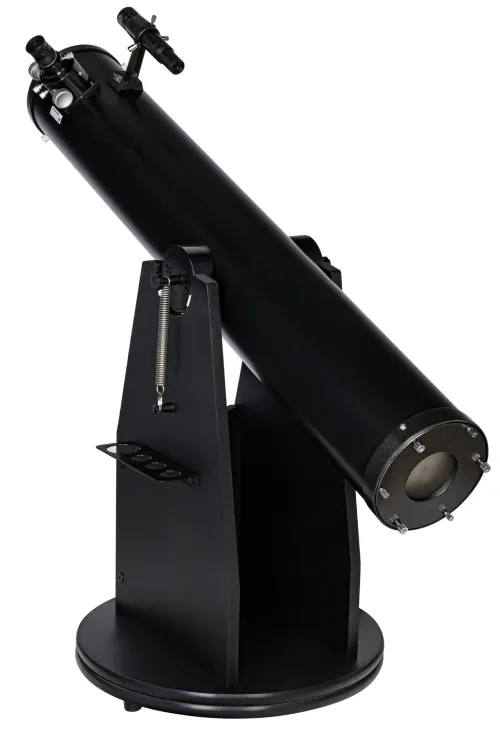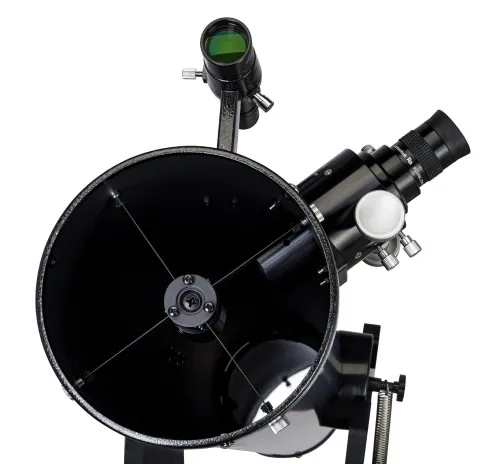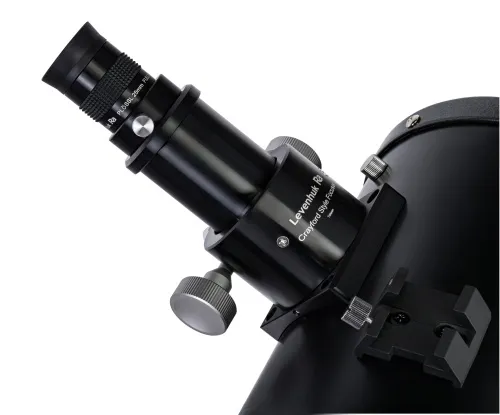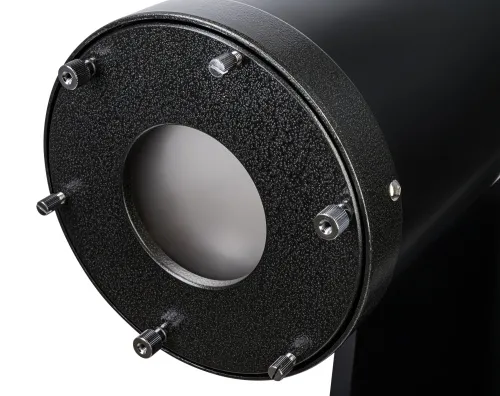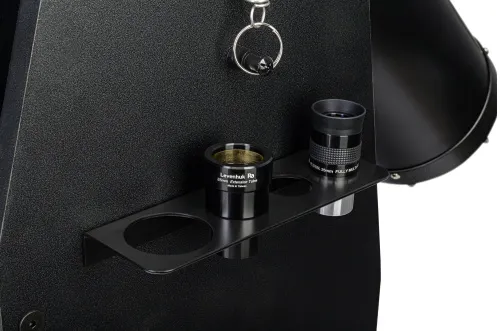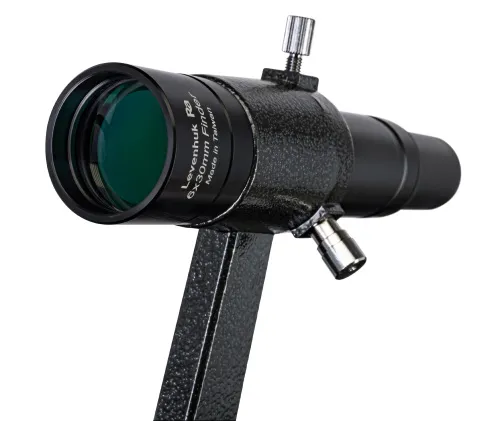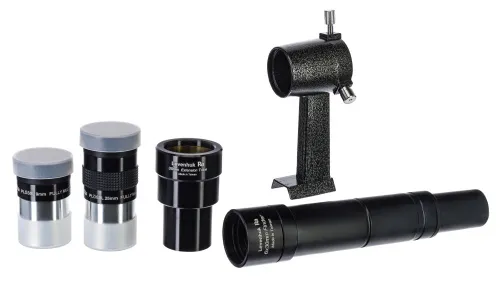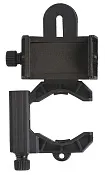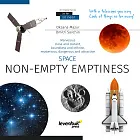Levenhuk Ra 150N Dobson Telescope
Newtonian telescope. Aperture: 153 mm. Focal length: 1215 mm
| Product ID | 61704 |
| Brand | Levenhuk, Inc., USA |
| Warranty | lifetime |
| EAN | 5905555002637 |
| Package size (LxWxH) | 127x41x36 cm |
| Shipping Weight | 23 kg |
The Levenhuk Ra 150N Dobson telescope is an easy to use optical instrument for observing deep sky objects, including bright and faint galaxies, star clusters, and nebulae. Some of them can be observed in detail. You can also study the planets of the solar system. Up to Saturn, they are clearly visible. The telescope is suitable for beginners as well as experienced users. Due to its high image quality and ergonomic design, it will not disappoint even the most demanding astronomer.
The optics include an aluminum coated parabolic mirror
The optical design of the telescope is based on the primary mirror with a 153mm diameter. Since it features a paraboloid shape, even at the maximum useful magnification, optical distortions do not appear in the picture. The primary mirror has an aluminum coating with a reflectivity index of 92~96%. This produces high-contrast and vivid images of objects in the night sky. The Crayford Focuser enables you to obtain a maximally sharp image in any conditions.
Quick start kit
The kit includes two symmetrical eyepieces: 9mm and 25mm. They provide a good view and allow you to quickly start studying the starry sky. The search for astronomical objects is carried out using a 6x30mm optical finder.
Features:
- Parabolic primary mirror with a 153mm diameter
- Special aluminum coating with a reflectivity index of 92~96%
- Easy-to-use Dobsonian mount
- Crayford focuser for precise focus adjustments
The kit includes:
- Telescope optical tube
- Dobsonian mount
- Plössl 9mm eyepiece
- Plössl 25mm eyepiece
- Finder 6x30mm
- Finderscope base
- User manual and lifetime warranty
| Product ID | 61704 |
| Brand | Levenhuk, Inc., USA |
| Warranty | lifetime |
| EAN | 5905555002637 |
| Package size (LxWxH) | 127x41x36 cm |
| Shipping Weight | 23 kg |
| Optical design | reflector |
| Optical scheme | Newtonian |
| Optics material | BK-7 |
| Optics coating | aluminum |
| Primary mirror diameter (aperture), mm | 153 |
| Secondary mirror obstruction, mm | 31 |
| Lens (mirror) shape | parabolic |
| Focal length, mm | 1215 |
| Highest practical power, x | 306 |
| Aperture ratio | f/8 |
| Resolution threshold, arcseconds | 0.69 |
| Limiting stellar magnitude | 14.2 |
| Eyepieces | Plössl 9mm (135х), Plössl 25mm (48х) |
| Eyepiece barrel diameter, in | 1.25 |
| Objective lens obstruction: by area | 9 |
| Objective lens obstruction: by diameter | 20 |
| Finderscope | optical, 6x30 |
| Focuser | 1.25", Crayford |
| Accessory tray | ✓ |
| Telescope control | manual |
| Mount | Dobsonian |
| Mount material | wood |
| Operating temperature range, °C | -5...+35 |
| Optical tube material | metal |
| User level | experienced users |
| Assembly and installation difficulty level | complicated |
| Observed object | deep-sky objects |
Convenient diagrams that describe how to install additional accessories on refractors and catadioptric telescopes
Find out how to assemble a telescope on an example of the Levenhuk Skyline 90x900 EQ telescope
This short guide will help you avoid typical mistakes and learn more about telescope and mounting types
The basics of astronomical observations for beginners
In this article we have gathered answers to some of the most frequently asked questions about telescopes
The most interesting celestial objects you can observe with Levenhuk telescopes
How telescopes work?
You can actually perform observations from your balcony!
All about telescope sizes, types, magnification, and mounts
Learn how to set up and use the telescope properly
Astronomy in light-polluted skies. Find out what you can observe in the city
Read an interesting comprehensive article on telescopes for little astronomers
The pictures are made with Levenhuk telescopes
Celestial objects you can observe with telescopes of different apertures
Colored and vivid images of galaxies, planets and star clusters entrance everyone who is fascinated by boundless space
Find an interesting review on the history of the changes to a refracting telescope
To make the process of choosing a telescope easier, we will tell you about the characteristics of the most popular types of telescopes today
Learn everything you need to know about refractor telescopes to make the right choice

